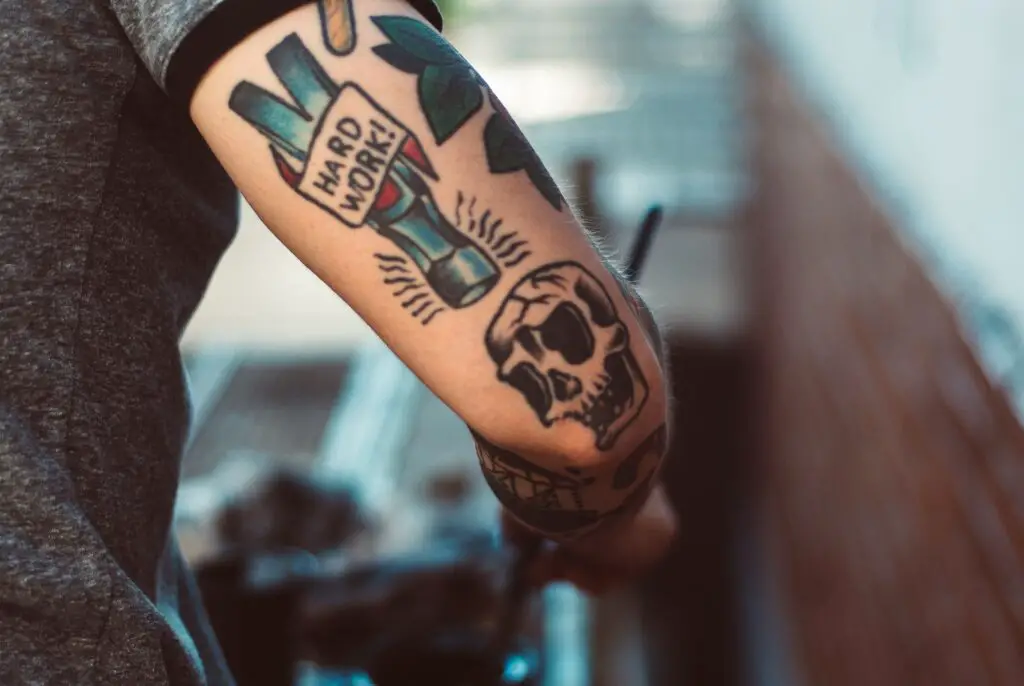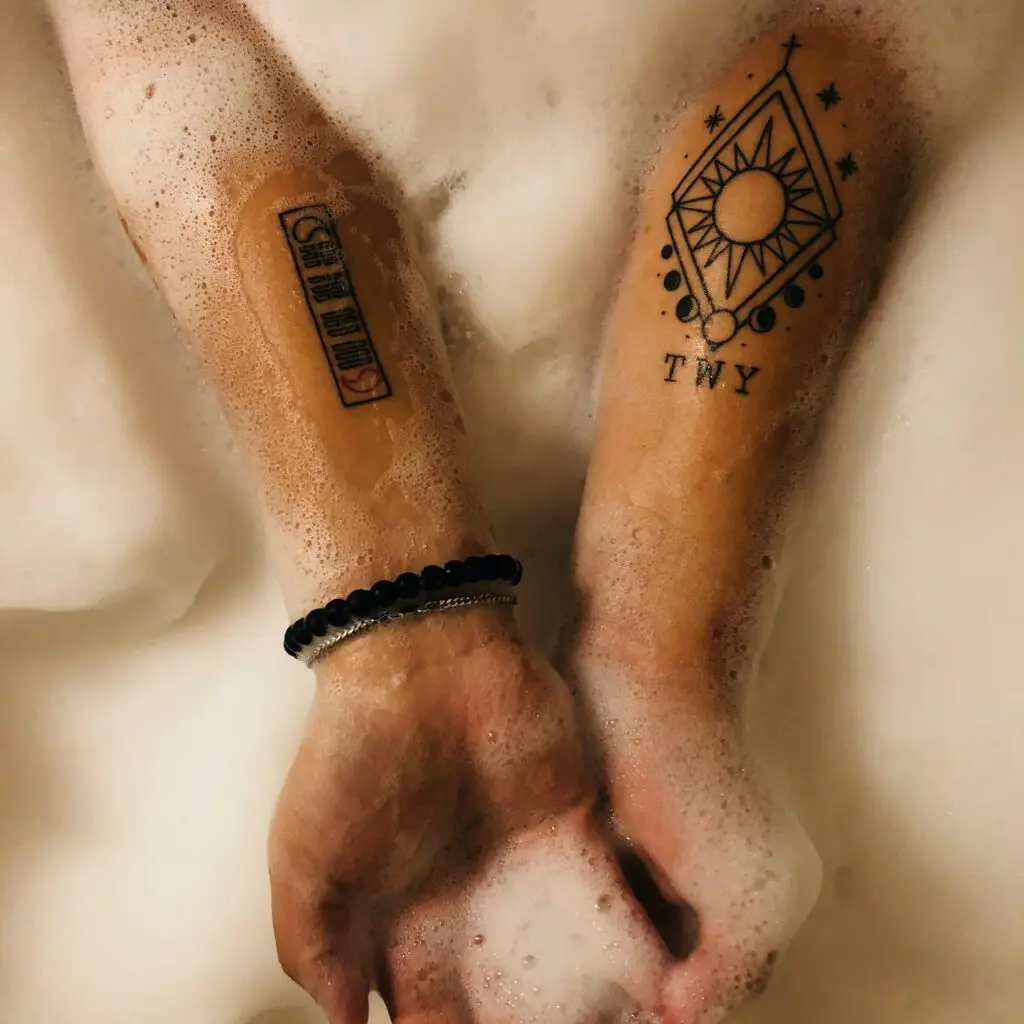Contents
Ditch tattoo blowout
Tattoos are powerful expressions of individuality and personal style, but the unfortunate occurrence of a tattoo blowout can dampen the overall aesthetic impact. A tattoo blowout happens when ink spreads beyond the intended boundaries, resulting in blurred lines and a less-defined design. This phenomenon can significantly impact the appearance of the tattoo, leading individuals to seek effective strategies for addressing and “ditching” tattoo blowouts.
In this article, we’ll delve into the intricacies of tattoo blowouts, understanding why they occur and the impact they have on the visual appeal of your ink. The primary goal is to explore a range of strategies aimed at minimizing and, where possible, eliminating the appearance of tattoo blowouts. Whether you’re currently dealing with a blowout or want to equip yourself with knowledge for future ink endeavors, this comprehensive guide will provide valuable insights into addressing and overcoming the challenges posed by tattoo blowouts. Let’s embark on a journey to discover effective ways to enhance the appearance of your tattoos and regain confidence in showcasing your unique body art.

Understanding Tattoo Blowouts
Definition of a Tattoo Blowout:
A tattoo blowout is a phenomenon that occurs when the ink from a tattoo spreads beyond the originally intended boundary lines. Instead of staying precisely within the defined edges of the design, the ink can disperse into the surrounding skin, leading to a blurred or smudged appearance. This unintended spreading can compromise the crispness and clarity of the tattoo, altering its overall visual impact.
Causes of Tattoo Blowouts:
Needle Depth and Pressure:
Explanation: One of the primary causes of tattoo blowouts is the improper use of needles during the tattooing process. If the needle penetrates too deeply into the skin or if excessive pressure is applied, it can lead to the ink spreading beyond the intended area.
Insight: Understanding the delicate balance between needle depth and pressure is crucial in minimizing the risk of blowouts during the tattooing process.

Thin or Fragile Skin:
Explanation: Individuals with thin or fragile skin are more susceptible to tattoo blowouts. The fragility of the skin can result in the ink dispersing more easily, especially if the tattoo is located in an area where the skin is thinner.
Insight: Tattoo artists must adapt their techniques based on the thickness and resilience of the client’s skin to reduce the likelihood of blowouts.
Ink Viscosity:
Explanation: The viscosity of the tattoo ink itself can play a role in blowouts. Thinner inks may spread more readily under the skin, leading to unintended diffusion beyond the original design.
Insight: Tattoo artists may choose inks carefully, considering their consistency and adjusting techniques accordingly to avoid blowouts.
Overworking the Skin:
Explanation: Excessive tattooing in a specific area, either during a single session or over multiple sessions, can contribute to blowouts. Overworking the skin increases the chances of ink spreading beyond the intended boundaries.
Insight: Both tattoo artists and clients should be mindful of the importance of allowing adequate healing time between sessions to prevent overworking the skin.
Skin Conditions and Elasticity:
Explanation: Skin conditions and variations in skin elasticity can influence the likelihood of blowouts. Conditions that affect the skin’s integrity, along with variations in elasticity, may contribute to ink dispersal.
Insight: Tattoo artists should assess the condition of the client’s skin and tailor their approach to minimize the risk of blowouts.
Understanding the intricacies of why tattoo blowouts occur is the first step in developing effective strategies to address and prevent them. By examining these common causes, individuals can make informed decisions and work collaboratively with tattoo artists to minimize the risk of blowouts during the tattooing process.
Consulting with Your Tattoo Artist
Effective communication with your original tattoo artist is a critical step in addressing and navigating the challenges posed by a tattoo blowout. Here’s why consulting with your tattoo artist is essential and how this collaborative approach can lead to meaningful solutions:
1. Understanding the Unique Circumstances:
Importance of Communication: Your tattoo artist has firsthand knowledge of the techniques, needle types, and ink used during your tattoo session. Open communication allows you to discuss specific details of the process and any concerns you may have.
Insightful Collaboration: By sharing your observations and experiences, your tattoo artist gains valuable insights into the unique circumstances surrounding your tattoo and potential factors contributing to the blowout.
2. Professional Insights into the Blowout:
Importance of Communication: Tattoo artists are skilled professionals who understand the intricacies of skin, ink, and tattooing techniques. Discussing the blowout with your artist provides an opportunity for them to analyze the issue from a technical perspective.
Insightful Collaboration: Your tattoo artist can offer insights into the possible causes of the blowout, whether it be needle depth, ink viscosity, or other technical aspects. This collaborative analysis lays the groundwork for informed decision-making.
3. Exploring Potential Solutions Together:
Importance of Communication: A collaborative approach involves discussing potential solutions with your tattoo artist. Whether it’s exploring touch-up options, considering cover-up tattoos, or seeking aftercare advice, your artist’s input is invaluable.
Insightful Collaboration: Your tattoo artist, having a deep understanding of the original design and technique, can guide feasible solutions. Together, you can explore options that align with your preferences and the artist’s expertise.
4. Assessing Tattoo Placement and Future Considerations:
Importance of Communication: Discussing the blowout with your tattoo artist allows for an assessment of the tattoo’s placement and the impact on future tattooing in the same area.
Insightful Collaboration: Your tattoo artist can guide whether adjustments to the original design, cover-up tattoos, or relocating future tattoos may be suitable to address the blowout effectively.
5. Building Trust and Confidence:
Importance of Communication: Establishing open communication fosters trust between you and your tattoo artist. This trust is crucial when navigating challenges such as blowouts.
Insightful Collaboration: Collaborating on solutions builds confidence in the process. Knowing that you and your artist are working together towards a resolution can alleviate concerns and uncertainties.
6. Setting Realistic Expectations:
Importance of Communication: Openly discussing the blowout allows for setting realistic expectations regarding potential solutions, outcomes, and the timeline for any corrective measures.
Insightful Collaboration: Your tattoo artist can provide realistic insights into what can be achieved, helping you make informed decisions and manage expectations throughout the resolution process.
In summary, consulting with your original tattoo artist is not only essential for gaining technical insights but also for building a collaborative partnership in addressing a tattoo blowout. Open communication sets the stage for exploring solutions together, creating a positive and informed approach to enhancing the appearance of your tattoo.

Patience in the Healing Process
1. Emphasizing the Significance of Natural Healing:
Importance of Patience: One of the fundamental aspects of addressing a tattoo blowout is recognizing the importance of allowing the tattoo to heal naturally. Patience is key during this crucial stage of the process.
Healing as a Natural Process: Tattoo blowouts often become more apparent during the initial stages of healing. Resisting the urge to intervene allows the body’s natural healing mechanisms to come into play.
2. Understanding the Healing Stages:
Importance of Patience: Tattoo healing occurs in stages, and each phase plays a role in the final appearance of the ink. Understanding these stages is essential in managing expectations.
Evolution of the Blowout: The appearance of a blowout can change during the healing process. Initially, the ink may spread, but as the skin heals, the edges of the tattoo may become clearer. Patience during this evolution is crucial for a comprehensive assessment.
3. Avoiding Interference and Overanalysis:
Importance of Patience: Temptations to overanalyze or scrutinize the tattoo blowout can be strong during the healing process. However, interference, such as excessive rubbing or picking, can exacerbate the issue.
Allowing the Process: Patience involves resisting the impulse to constantly inspect the tattoo. Allowing the healing process to unfold without interference promotes a more accurate evaluation of the blowout’s progression.
4. Recognizing Individual Healing Timelines:
Importance of Patience: Every individual’s body responds differently to the tattooing process, and healing timelines vary.
Customized Healing: Some individuals may experience quicker healing, while others may require more time. Patience involves acknowledging and respecting the unique healing timeline of your body.
5. Monitoring Changes Gradually:
Importance of Patience: Rather than expecting immediate changes, patience dictates gradual and attentive monitoring of the tattoo’s evolution during the healing stages.
Evaluating Progression: By monitoring changes over time, you gain a more accurate understanding of the blowout’s progression. This patient approach sets the stage for informed decisions regarding potential interventions.
6. Seeking Professional Guidance When Necessary:
Importance of Patience: If concerns persist during the healing process, exercising patience doesn’t mean enduring unnecessary distress. It means seeking professional guidance judiciously.
Consulting Professionals: Patience involves waiting for the appropriate healing time, but if uncertainties persist, consulting your original tattoo artist or a professional in the field provides valuable insights and reassurance.
7. Setting Realistic Expectations:
Importance of Patience: Patience is intertwined with setting realistic expectations. Acknowledging that changes may take time helps in managing emotions and fostering a positive mindset.
Optimism in the Process: While the healing process may require time, optimism about the potential improvement of the blowout encourages a more patient and resilient approach.
In conclusion, patience in the healing process is a cornerstone of addressing tattoo blowouts. Emphasizing the significance of natural healing, understanding the evolving stages, and avoiding premature interference contribute to a patient and informed approach. Patience allows for a more accurate assessment of the blowout’s progression and sets the foundation for decisions regarding potential interventions.
Cover-Up Options
1. Introduction to Cover-Up Tattoos:
Strategic Concealment: When dealing with a tattoo blowout, cover-up tattoos emerge as a strategic solution to disguise and minimize the appearance of the undesired ink spreading.
Purposeful Redesign: The concept involves incorporating a new design that strategically conceals the blowout while maintaining an aesthetically pleasing and cohesive look.
2. Considerations When Opting for a Cover-Up:
a. Design Choices:
Comprehensive Redesign: Opting for a cover-up allows for a comprehensive redesign that not only conceals the blowout but transforms the entire tattoo into a new, visually appealing piece.
Strategic Elements: Consider design elements that effectively mask the blowout without compromising the overall aesthetics. A skilled tattoo artist can guide you in choosing patterns, shapes, or images that complement your preferences.
b. Finding a Skilled Tattoo Artist:
Expertise in Cover-Ups: Not all tattoo artists specialize in cover-up tattoos. When considering this option, seek out artists with expertise in cover-up techniques.
Portfolio Review: Review the artist’s portfolio to assess their proficiency in cover-up work. Look for examples where they successfully concealed unwanted tattoos while delivering high-quality, visually striking designs.
c. Color and Size Considerations:
Strategic Use of Colors: The choice of colors plays a crucial role in cover-up tattoos. A skilled artist can strategically incorporate hues that effectively mask the blowout.
Size Adaptation: Considerations regarding the size of the cover-up of the original tattoo are vital. Skilled artists can adjust the size to ensure adequate coverage while maintaining balance and harmony in the new design.
d. Open Communication:
Transparent Discussions: Open communication with your chosen tattoo artist is paramount. Discuss your concerns, preferences, and expectations regarding the cover-up design.
Collaborative Decision-Making: A collaborative approach ensures that both you and the artist are aligned in the vision for the cover-up, fostering a positive and informed decision-making process.
e. Healing Expectations:
Realistic Healing Timelines: Understand that cover-up tattoos, like any new tattoo, require proper healing time. Patience is crucial during this phase to allow the skin to recover and reveal the final, transformed design.
Follow Aftercare Instructions: Adhering to aftercare instructions provided by your tattoo artist is essential for the optimal healing of the cover-up. Proper care promotes vibrant colors and enhances the longevity of the new design.
3. Transformation and Empowerment:
Embracing a Fresh Start: Opting for a cover-up is not just about concealing a blowout; it’s an opportunity for a fresh start. Embrace the transformation as a positive and empowering journey, reclaiming ownership of your body art.
In considering cover-up options, individuals have the opportunity to turn a perceived flaw into a beautiful, purposeful redesign. With careful consideration of design choices, finding a skilled tattoo artist, and maintaining open communication, cover-up tattoos can not only effectively mask blowouts but also result in a renewed and visually striking piece of body art.

Laser Tattoo Removal
1. Exploring Laser Tattoo Removal:
Addressing Severe Cases: In more severe instances of tattoo blowouts or when individuals desire complete removal, laser tattoo removal stands out as a viable option.
Precision and Targeting: Laser technology allows for precise targeting of the tattooed area, breaking down ink particles for natural removal by the body.
2. Understanding the Laser Removal Process:
a. How Laser Removal Works:
Breaking Down Ink: Laser beams are directed at the tattooed skin, breaking down the pigments into smaller particles.
Natural Elimination: The body’s immune system then works to eliminate these particles over time, gradually fading the tattoo.
b. Considerations for Laser Removal:
Skin Type and Colors: Different laser wavelengths are effective for various colors, and the success of removal can vary based on skin type.
Multiple Sessions: Laser removal often requires multiple sessions spaced over weeks to allow the skin to heal between treatments.
c. Potential Outcomes and Results:
Gradual Fading: Results are not immediate, and the tattoo fades gradually with each session.
Complete Removal vs. Fading: While complete removal is possible, some individuals may opt for significant fading if complete removal is challenging or not their primary goal.
3. Factors to Consider Before Laser Removal:
a. Pain and Discomfort:
Pain Level: Laser removal can be uncomfortable, with sensations often described as similar to rubber band snaps.
Topical Anesthetics: Topical anesthetics may be applied to mitigate discomfort during the procedure.
b. Risks and Side Effects:
Skin Reactions: Temporary side effects may include redness, swelling, or blistering, with rare instances of scarring.
Skin Sensitivity: Individuals with sensitive skin may experience more pronounced reactions.
c. Consultation and Professional Guidance:
Prior Consultation: A crucial step is to consult with a professional specializing in laser tattoo removal.
Assessment of Suitability: The practitioner will assess factors such as skin type, tattoo colors, and overall health to determine the suitability of laser removal.
4. Aftercare and Recovery:
Protecting Treated Area: Aftercare involves protecting the treated area from sun exposure and practicing good skincare.
Healing Timeline: The skin requires time to heal between sessions, and adherence to aftercare instructions promotes optimal healing.
5. Managing Expectations:
Realistic Expectations: Laser removal does not guarantee complete erasure, and the extent of removal can vary.
Collaborative Decision-Making: Open communication with the practitioner ensures realistic expectations, addressing any concerns or questions.
Laser tattoo removal represents an advanced and effective method for addressing severe cases of tattoo blowouts or for those seeking complete removal. However, individuals considering this option should carefully weigh the process, potential outcomes, and associated considerations. A thorough consultation with a qualified professional ensures informed decision-making and sets the stage for a successful and well-managed laser removal journey.
Enhancements and Redefinition
1. Harnessing the Expertise of Skilled Tattoo Artists:
Artistic Expertise: Skilled tattoo artists possess a high level of artistic expertise, allowing them to navigate and enhance the lines of a tattoo with precision.
Focused Redefinition: The focus lies in strategically redefining lines to minimize the appearance of a blowout while maintaining the integrity of the original design.
2. The Process of Enhancements and Redefinition:
a. Precision in Redefining Lines:
Artistic Precision: Skilled artists use their expertise to meticulously redefine lines affected by a blowout.
Balancing Act: The goal is to strike a balance, minimizing the impact of the blowout without compromising the overall aesthetic.
b. Camouflaging the Blowout:
Strategic Camouflage: Artists employ techniques to strategically camouflage the areas affected by the blowout.
Incorporating New Elements: The addition of new elements or shading can divert attention from the blowout, creating a more cohesive and visually pleasing tattoo.
3. Limitations and Possibilities of Enhancements:
a. Limitations:
Size Constraints: In some cases, the size of the blowout may pose limitations on the extent of redefinition.
Severity of Blowout: The severity of the blowout can impact the possibilities for enhancement. Severe cases may have more limited options.
b. Possibilities:
Strategic Cover-Up: Enhancements may involve strategically incorporating elements that cover or divert attention from the affected areas.
Creative Solutions: Creative solutions, such as incorporating background elements or adapting the design, offer possibilities for minimizing the visual impact of the blowout.
4. Collaboration between Artist and Client:
a. Open Communication:
Transparent Discussions: Open communication between the client and the tattoo artist is crucial in understanding expectations and limitations.
Sharing Concerns: Clients should openly share concerns about the blowout, allowing the artist to tailor their approach accordingly.
b. Realistic Expectations:
Education on Possibilities: Tattoo artists educate clients on the possibilities and limitations of enhancing and redefining a tattoo affected by a blowout.
Setting Realistic Goals: Setting realistic goals ensures that both parties are aligned in their expectations and the desired outcome.
5. The Significance of Skill and Experience:
Artistic Skill: The success of enhancements depends on the artistic skill and experience of the tattoo artist.
Adapting Techniques: Experienced artists can adapt techniques to the specific challenges presented by blowouts, ensuring a nuanced and effective approach.
6. The Evolving Nature of the Tattoo:
Tattoo Evolution: Tattoos are dynamic and can evolve. Enhancements and redefinition contribute to the ongoing evolution of the tattoo, adapting to changes in the skin and ensuring long-term visual appeal.
In conclusion, enhancements and redefinition by skilled tattoo artists offer a tailored approach to minimizing the appearance of blowouts. While there are limitations based on factors such as size and severity, the possibilities lie in the creative solutions and artistic skill of the tattoo artist. Open communication, realistic expectations, and a collaborative approach between the artist and client are key elements in achieving a refined and visually pleasing outcome.
Scar Camouflage Techniques
1. Introduction to Scar Camouflage Techniques:
Addressing Blowouts Resulting in Scarring: In cases where blowouts result in scarring, scar camouflage techniques emerge as a specialized solution.
Blending Scar Tissue: The primary goal is to utilize specific methods that effectively blend scar tissue with the surrounding skin, creating a seamless and natural appearance.

2. Methods Used in Scar Camouflage:
a. Color Matching:
Precision in Color Selection: Specialized artists focus on selecting ink colors that closely match the individual’s skin tone.
Blending Technique: By precisely matching colors, the artist employs blending techniques to seamlessly integrate the scar into the surrounding skin.
b. Texturing Techniques:
Creating Natural Texture: Scarred areas may lack the natural texture of surrounding skin. Artists use various techniques to recreate texture, including stippling and layering.
Optical Illusions: Texturing techniques create optical illusions that make the scar less noticeable, contributing to a more cohesive overall appearance.
c. Strategic Design Elements:
Incorporating Design Elements: Scar camouflage involves incorporating design elements that strategically divert attention from the scar.
Artistic Distraction: These design elements serve as artistic distractions, drawing the eye away from the scarred area and contributing to a harmonious composition.
3. Collaborative Approach with the Client:
a. Consultation and Assessment:
Detailed Consultation: Scar camouflage begins with a detailed consultation between the specialized artist and the client.
Assessing Scarring: The artist assesses the nature of the scarring, including its size, color, and texture, to tailor the approach accordingly.
b. Customized Treatment Plan:
Individualized Solutions: Based on the assessment, the artist creates a customized treatment plan that addresses the specific characteristics of the scar.
Client Input: The client’s input is crucial in determining preferences, ensuring that the final result aligns with their aesthetic goals.
4. Healing and Aftercare:
a. Careful Aftercare Instructions:
Optimizing Healing: After completing scar camouflage, artists provide careful aftercare instructions to promote optimal healing.
Minimizing Discomfort: Aftercare also minimizes discomfort and reduces the risk of complications during the healing process.
b. Follow-Up Sessions:
Monitoring Progress: Scar camouflage may involve multiple sessions. Follow-up sessions allow the artist to monitor progress and make any necessary adjustments.
Fine-tuning the Result: Fine-tuning the result ensures that the scar blends seamlessly with the surrounding skin over time.
5. Artistic Skill and Specialization:
Specialized Training: Artists specializing in scar camouflage undergo specialized training to master the techniques required for blending scars.
Adapting to Individual Cases: The ability to adapt techniques to individual cases showcases the artistic skill and expertise of the specialized artist.
6. Psychological Impact:
Boosting Confidence: Beyond the physical aspect, scar camouflage has a psychological impact, boosting confidence and helping individuals reclaim a sense of normalcy.
Empowering Individuals: The process of scar camouflage is empowering, allowing individuals to redefine their relationship with their bodies and the perception of their scars.
In summary, scar camouflage techniques provide a specialized and artistic approach to addressing scarring resulting from blowouts. Through color matching, texturing techniques, and strategic design elements, specialized artists collaborate with clients to create individualized treatment plans. The careful consideration of aftercare, follow-up sessions, and the psychological impact highlights the comprehensive nature of scar camouflage as a transformative and empowering process.
Proper Aftercare for New Tattoos
1. Preventing Future Blowouts through Aftercare:
Proactive Approach: Proper aftercare not only aids in the healing of a new tattoo but also plays a crucial role in preventing future blowouts.
Maintaining Skin Health: By following recommended aftercare practices, individuals contribute to the overall health and resilience of their skin, minimizing the risk of complications like blowouts.
2. Tips for Proper Aftercare to Prevent Future Blowouts:
a. Gentle Cleaning:
Mild Cleansers: Use a mild, fragrance-free cleanser to clean the tattooed area. Harsh or scented products may irritate the skin and potentially contribute to blowouts.
Gentle Patting: Pat the tattoo dry with a clean, soft cloth rather than rubbing. Gentle care minimizes stress on the healing skin and reduces the risk of blowouts.
b. Moisturizing:
Non-Irritating Moisturizers: Apply a thin layer of non-scented, hypoallergenic moisturizer to keep the tattooed skin hydrated. Proper hydration supports skin health and elasticity, reducing the likelihood of blowouts.
Regular Moisturization: Maintain a consistent moisturizing routine, especially during the initial healing weeks.
c. Avoiding Sun Exposure:
Sun Protection: Shield the tattoo from direct sunlight, as UV rays can damage healing skin and increase the risk of blowouts. Use clothing or a recommended tattoo-specific sunscreen with adequate SPF.
Limited Sun Exposure: Minimize sun exposure during the initial healing phase and continue to protect the tattooed area even after it has fully healed.
d. Clothing Choices:
Loose and Breathable Fabrics: Opt for loose and breathable clothing to prevent friction and irritation on the tattoo. Tight or abrasive fabrics may contribute to blowouts, especially in sensitive areas.
e. Avoiding Scratching or Picking:
Hands-Off Approach: Resist the urge to scratch or pick at the healing tattoo, as this can disrupt the healing process and potentially lead to blowouts.
Mindful Touch: If itching occurs, gently tap or pat the area rather than scratching. Maintaining a mindful touch promotes optimal healing.
f. Hydrated Lifestyle:
Adequate Water Intake: Stay well-hydrated from within. Proper hydration supports overall skin health, making it more resistant to stressors that could contribute to blowouts.
Balanced Diet: A balanced diet with essential nutrients contributes to the health and resilience of the skin.

3. Emphasizing the Role of Proactive Aftercare:
a. Consistent Follow-Up:
Post-Healing Care: After the initial healing period, continue to follow good aftercare practices. Consistent care contributes to the long-term health and vibrancy of the tattoo.
Regular Skin Checks: Periodically check the tattooed area for any signs of changes or irregularities. Early detection of issues allows for prompt intervention, reducing the risk of complications.
b. Communication with the Tattoo Artist:
Open Dialogue: Maintain open communication with the original tattoo artist. Discuss any concerns or questions related to aftercare and seek their guidance on preventive measures.
Scheduled Touch-Ups: If necessary, schedule touch-ups with the tattoo artist. Addressing minor issues promptly prevents them from escalating into potential blowouts.
c. Professional Consultation for Blowouts:
Early Intervention: If signs of a blowout or other issues arise, seek professional consultation promptly. Early intervention allows for appropriate measures to be taken to address and minimize potential complications.
Educational Guidance: Professionals can provide educational guidance on aftercare practices tailored to individual skin types and tattoo locations.
d. Holistic Approach to Skin Health:
Overall Skin Care: Adopt a holistic approach to skin health beyond the tattooed area. Nurturing the entire skin surface contributes to a resilient canvas less prone to complications.
Regular Moisturization: Regularly moisturize the entire skin, not just the tattooed portion. Healthy, well-maintained skin reduces the risk of issues such as blowouts.
In conclusion, proper aftercare for new tattoos extends beyond healing; it plays a pivotal role in preventing future blowouts. By adopting a proactive and consistent aftercare routine, individuals contribute to the long-term health and appearance of their tattoos. Emphasizing gentle practices, sun protection, and a holistic approach to skin health empowers individuals to safeguard their body art and minimize the risk of complications.
Conclusion
In the journey of addressing and “ditching” tattoo blowouts, a comprehensive approach that combines informed decision-making, patience, and collaboration with professionals is paramount. Let’s recap the key strategies outlined in this article:
1. Understanding the Nature of Blowouts:
Acknowledging that blowouts can occur during the tattooing process, resulting in ink spreading beyond the intended boundaries.
2. Collaborating with the Original Tattoo Artist:
Stressing the importance of open communication with the original tattoo artist to gain insights, explore solutions, and make informed decisions regarding potential interventions.
3. Patience in the Healing Process:
Emphasizing the significance of allowing the tattoo to heal naturally and understanding the evolving stages of the healing process.
4. Exploring Cover-Up Options:
Introducing cover-up tattoos as a strategic solution to disguise and minimize the appearance of blowouts, considering design choices, and finding skilled tattoo artists with expertise in cover-ups.
5. Laser Tattoo Removal for Severe Cases:
Exploring laser tattoo removal as an option for more severe cases, discussing the process, considerations, and potential outcomes associated with laser removal.
6. Enhancements and Redefinition by Skilled Artists:
Highlighting how skilled tattoo artists can enhance and redefine tattoo lines to minimize the appearance of blowouts, acknowledging both the limitations and creative possibilities of this approach.
7. Scar Camouflage Techniques:
Introducing scar camouflage techniques for cases where blowouts result in scarring, emphasizing the role of specialized artists in blending scar tissue with the surrounding skin.
8. Proactive Aftercare for New Tattoos:
Providing tips for proper aftercare to prevent future blowouts, emphasizing the proactive role of aftercare in maintaining tattoo health and appearance.
9. Consistent Follow-Up and Professional Consultation:
Encouraging consistent follow-up after the initial healing period, maintaining open communication with the tattoo artist, and seeking professional consultation promptly if issues arise.
In conclusion, the satisfaction of a tattoo experience hinges on a holistic approach that involves collaboration, patience, and informed decision-making. By understanding the nature of blowouts, exploring various strategies, and embracing a proactive aftercare routine, individuals can navigate the challenges associated with tattoo blowouts. Remember that every tattoo journey is unique, and the collaboration between the client and professionals is key to achieving a satisfying and visually appealing outcome.





